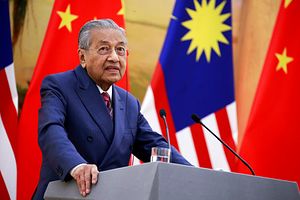Earlier this week, China and Malaysia made further progress on the realization of a landmark warship deal. The developments put the spotlight on a key development within evolving bilateral defense ties that have continued following the entry of a new Malaysian government in May.
As I have noted before in these pages, China and Malaysia have made gradual inroads over the years in their defense ties as part of their wider bilateral relationship. Since the inking of a memorandum of understanding on defense collaboration in 2005, inroads have been made incrementally in some areas like the establishment of regular consultative mechanisms, exercises, and even defense deals.
One of the deals that has been in the headlines a fair bit is the one reached under the previous government of Najib Razak in November 2016 where Malaysia had agreed to buy four littoral mission ships (LMS) from China. Under the deal, it was understood that Wuchang Shipbuilding would construct the first and second ships, while the third and fourth will be jointly built by Wuchang Shipbuilding and Malaysia’s local shipbuilding company Boustead Naval Shipyard Sdn Bhd (BNSSB).
While it is still early days, thus far the deal has continued on even amid some recalibration in China-Malaysia relations under the new Malaysian government, which saw the country’s longest-serving prime minister Mahathir Mohamad returning to office. The last public event tied to the LMS deal was the formal launching ceremony for the first LMS which was conducted at the Shuangliu base of Wuchang Shipbuilding on July 31.
This week, the China-Malaysia warship deal was in the spotlight again with the visit of Malaysia’s Defense Minister Mohamad Sabu. Sabu’s four-day visit, which lasted from October 23 to 26, constituted yet another trip to a major power since assuming his position earlier this year following his trip to the United States back in September.
Sabu had a range of engagements during the visit, including meeting Chinese officials such as Defense Minister Wei Fenghe. But he also oversaw ongoing progress of the warships deal, witnessing the keel laying for the first LMS and the steel cutting for the second LMS in Wuhan.
Not much in the way of detail was publicly disclosed about Sabu’s witnessing of these developments. Malaysia’s defense ministry said that the progress on the deal represented a positive not just for Sino-Malaysian relations, but also Malaysia’s own ongoing military modernization as well.
To be sure, it is still early days, and this is just one of a series of developments in the LMS deal from start to finish. Irrespective of those realities, the progress made on the deal will continue to be interesting to watch for indications about Malaysia’s foreign and defense policy more generally.

































